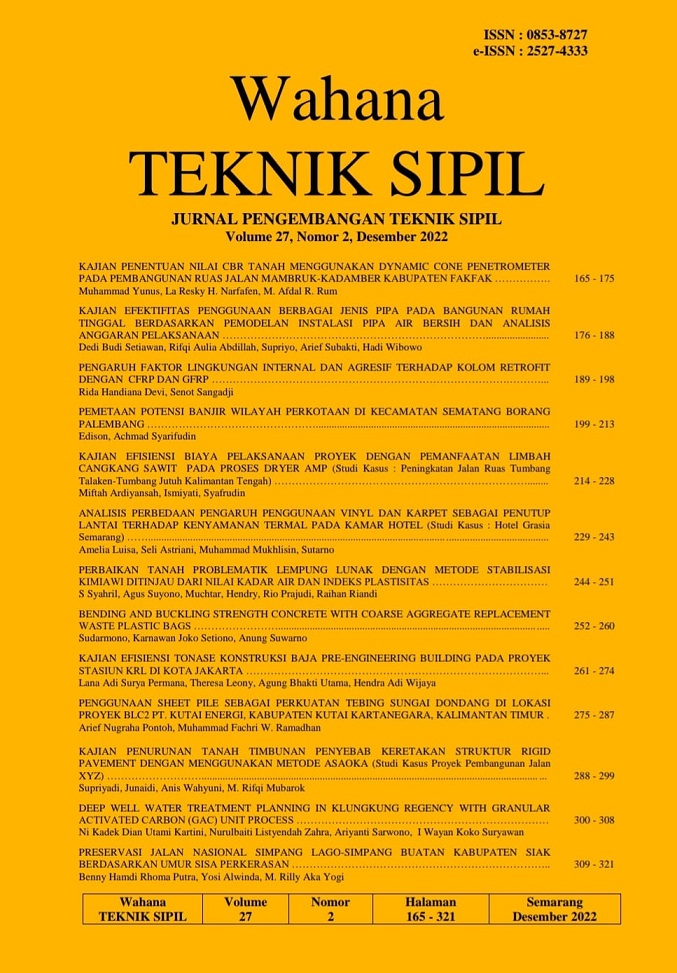PERBAIKAN TANAH PROBLEMATIK LEMPUNG LUNAK DENGAN METODE STABILISASI KIMIAWI DITINJAU DARI NILAI KADAR AIR DAN INDEKS PLASTISITAS
DOI:
https://doi.org/10.32497/wahanats.v27i2.4145Abstract
Soft clay soils generally have unfavorable characteristics or properties, when used as a basis for a construction. The characteristics of soft clay soil are having high soil compressibility, low carrying capacity, low permeability value, being cohesive and having a high level of soil activity. One form of effort to improve the characteristics of the soil's bad properties is to carry out stabilization. Stabilization is an activity of mixing soil with certain materials, and is expected to react with the soil, so that the soil characteristics become better. The methodology applied in this study is chemical stabilization, with mineral materials in the form of marble ash waste with 4 different types of variants. Based on the test results, there was a decrease in the value of the water content and soil plasticity index (PI) of 44.94% in variant 3 (20% marble ash waste) compared to the original soil. It is estimated that there is a reaction from the marble ash on soft clay soil, namely in the form of absorption of excess water contained in the soil and voids contained in the soil filled with marble waste, so that the adhesion between particles becomes better.
References
Arifin, Yulian Firmana, dan Gazali Rahman, 2019, Stabilization of Soft Soil with Cement and Palm Kernel Shell Ash Admixture.MATEC Web of Conferences280: 04011.
GarcÃa-Gaines, Rubén A., dan Susan Frankenstein, 2015, USCS and the USDA Soil Classification System, Development of a Mapping Scheme. UPRM and ERDC Educational and Research Internship Program (March): 37.
Hardiyatmo, Hary Christady, 2002,Mekanika Tanah 1. 3 ed. Yogyakarta: Gadjah Mada University Press.
Hendra, Suryadharma, dan John Tri Hatmoko, 2020, Perbaikan Tanah Lempung Berkapur Dengan Abu Sekam Padi, Studi kasus di desa Putat kecamatan Patuk Kab. Gunungkidul.17(April): 1”“13.
Marques, A, dan S Syahril, 2021 , The Effect of Adding Lime and Phosphoric Acid for Soft Soil Improvement on Unconfined Compressive Strength Value. Proceedings of the 2nd International Seminar of Science and AppliedTechnology (ISSAT 2021) 207 (Issat): 225”“30.
Nina Fahrriana, Yuliana Ismina, Ellida Novita Lydia, Hendra Ariesta, 2019, Analisis Klasifikasi Tanah Dengan Metode USCS (Meurandeh Kota Langsa).Jurnal Ilmiah Jurutera 6 (2) : 005”“013.
Razali, Makmun R, dan Olandri Wijaya, 2016, Nilai Cbr Pada Stabilisasi Tanah Dengan Semen Jalan Budi Utomo Unib Depan. Jurnal Inersia Oktober 8 (2): 67.
Setyono, Ernawan, Sunarto, dan Anggita Moro Gumilang, 2018, Pengaruh Penggunaan Bahan Serbuk Marmer Pada Stabilisasi Tanah Lempung Ekspansif.Media Teknik Sipil 16 (2) : 99 ”“107.
Surbakti, Rudianto, 2021, Prediksi Penurunan Konsolidasi Tanah Lunak Dengan Metode Analitis Dan Metode Element Hingga.Journal of Civil Engineering Building and Transportation 5(2): 83”“91.
Syahril, S., A.K. Somantri, dan A.A. Haziri, 2020, Study of stabilized soil clay soil characteristics using vulcanic ash and tailing as subgrade layers. IOP Conference Series: Materials Science and Engineering 830 (2).
Syahril, S, A. Suyono, dan I.R. Prajudi,2020, Reinforcement of Soft Soil on Slope Using Volcanic Ash and Phosphoric Acid Stabilization for Subgrade of Rigid Pavement. In Proceedings of the International Seminar of Science and Applied Technology (ISSAT 2020), Paris, France: Atlantis Press.
Ubaidillah, LR, dan Y Zaika, 2017,Pengaruh Ratio Slurry Air-kapur Pada Stabilisasi Tanah Lempung Ekspansif Untuk Metode Dsm. http://sipil.studentjournal.ub.ac.id/index.php/jmts/article/view/482.
Wardana, I Gusti Ngurah, 2009,Kelakuan Tanah Dengan Sifat Kembang-Susut Yang Tinggi Pada Stabilisasi Tanah Dengan Bahan Serbuk Marmer Dan Bahan Stabilia. Jurnal Ilmiah Teknik Sipil 13 (2): 161”“73.
Downloads
Published
Issue
Section
License
Authors who publish with this journal agree to the following terms:Authors retain copyright and grant the journal right of first publication with the work simultaneously licensed under a Creative Commons Attribution License that allows others to share the work with an acknowledgement of the work's authorship and initial publication in this journal.
Authors are able to enter into separate, additional contractual arrangements for the non-exclusive distribution of the journal's published version of the work (e.g., post it to an institutional repository or publish it in a book), with an acknowledgement of its initial publication in this journal.
Authors are permitted and encouraged to post their work online (e.g., in institutional repositories or on their website) prior to and during the submission process, as it can lead to productive exchanges, as well as earlier and greater citation of published work (See The Effect of Open Access).






